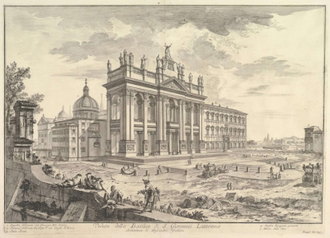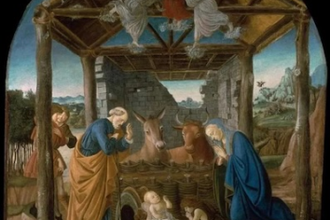Gospel in Art: Feast of the Dedication of the Lateran Basilica

Saint John Lateran main facade with Palace and Scala Santa on the right, engraving by Giovanni Battista Piranesi, 1749
Source: Christian Art
Gospel of 9 November 2024
John 2:13-22
Just before the Jewish Passover Jesus went up to Jerusalem, and in the Temple he found people selling cattle and sheep and pigeons, and the money changers sitting at their counters there. Making a whip out of some cord, he drove them all out of the Temple, cattle and sheep as well, scattered the money changers' coins, knocked their tables over and said to the pigeon-sellers, 'Take all this out of here and stop turning my Father's house into a market.' Then his disciples remembered the words of scripture: Zeal for your house will devour me. The Jews intervened and said, 'What sign can you show us to justify what you have done?' Jesus answered, 'Destroy this sanctuary, and in three days I will raise it up.' The Jews replied, 'It has taken forty-six years to build this sanctuary: are you going to raise it up in three days?' But he was speaking of the sanctuary that was his body, and when Jesus rose from the dead, his disciples remembered that he had said this, and they believed the scripture and the words he had said.
Reflection on the engraving
The Feast of the Dedication of the Lateran Basilica honours the dedication of the Archbasilica of Saint John Lateran in Rome, which is the cathedral of the Pope as the Bishop of Rome. Contrary to common belief, this basilica, not St. Peter's, is the mother church of the Roman Catholic Church and holds the title "Mother and Head of all the churches in the city and the world." The Lateran Basilica was originally dedicated in the year 324 AD by Pope Sylvester I, after Emperor Constantine donated the land and resources for its construction. It was the first public building consecrated for Christian worship, symbolising the new era of religious freedom for Christians after centuries of persecution.
The celebration of this feast highlights the unity of the Church, with the Lateran Basilica serving as a visible symbol of the universal Church's foundation in Christ and its communion with the Pope. The Gospel reading recounts the moment when Jesus cleanses the temple in Jerusalem. He drives out the money changers and sellers of animals, declaring, "Take all this out of here and stop turning my Father's house into a market." This passage resonates deeply with the meaning of the feast, as it reflects Jesus' zeal for the sanctity of the temple, a place meant for worship and prayer, not for profit and corruption.
Then Jesus points to a deeper reality when He says, "Destroy this temple, and in three days I will raise it up." While His listeners thought He was speaking about the physical temple, Jesus was referring to the temple of His body. This signifies a profound shift: the true temple of God is no longer limited to a physical structure but is now found in Jesus Christ Himself. His death and resurrection transformed the way we understand God's presence, reminding us that he dwells not only in sacred buildings like the Lateran Basilica but in each of us as members of the Body of Christ. Through this feast, we are reminded of our collective mission to build up the Church, both as a physical structure of unity and as a spiritual community rooted in Christ.
LINKS
Gospel in Art: https://christian.art/
Today's Reflection: https://christian.art/daily-gospel-reading/john-2-13-22-2024/


















